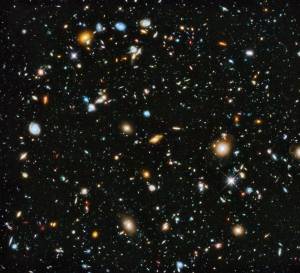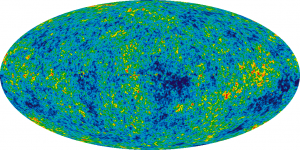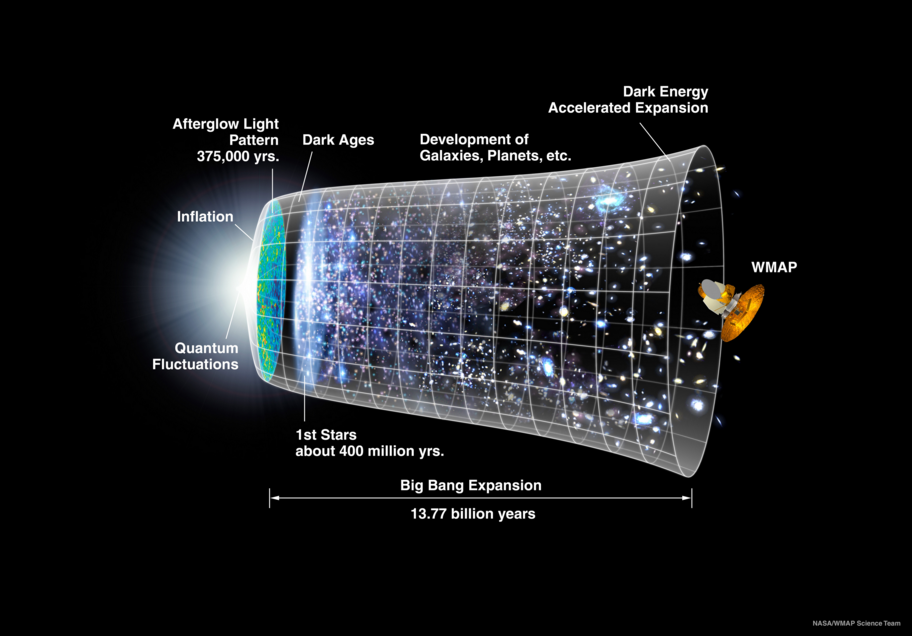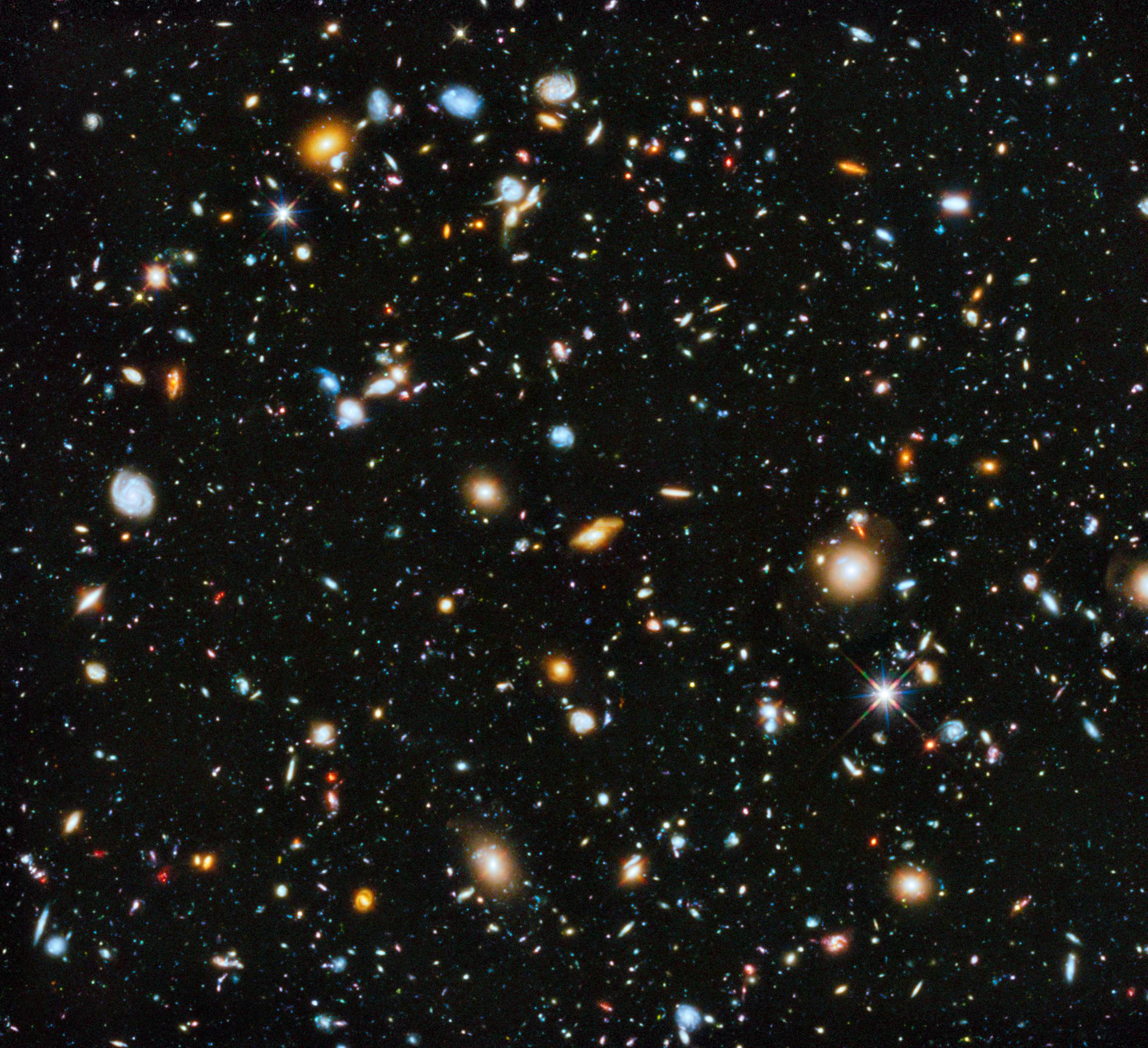The talk was to begin promptly at 1800 hours. The topic was “How the Universe Began”, and I had prepared myself for it by spending my entire working day reading Wikipedia articles and watching episodes of Bill Nye and The Magic Schoolbus. At 1720, I left work and set out to try to be early, arriving at Bar M in Urbana at around 1740.
I felt like I was too late. The place was already packed. The cozy lounge space had been converted into an impromptu classroom: the chairs were lined up and arranged to face a white wall behind a malfunctioning projector and the podium supporting it. People milled about, sipping on beer or wine, sitting in chairs or standing against whatever wall space they could find. I ordered a beer and stood off to one side.
It was the first in a series of Astronomy on Tap discussions hosted by U of I’s Department of Astronomy. The events are intended to be more forum than lecture, but nonetheless focus on increasing community members’ understanding of astronomy and our place in the universe over a beer (or wine, or a slice of pizza, or… well, you get the idea). It makes sense to me: it’s a lot easier to come to terms with the nihilistic insignificance of one’s pointless existence when one is tipsy.
I stood, rubbing shoulders (literally) with graduate students, undergraduates, professionals, and interested members of the general population. Although it was a bit chilly out, the room was warm and comfortable. Very soon after I arrived and settled into an awkward nook with my beer, the venue became standing-room only, with even the floor immediately in front of the projector screen occupied by interested observers. Due to the number of people, the HVAC unit must have switched from heat to air at some point.
As we approached H-Hour, it became clear that there was something amiss. While there was a laptop open and connected to the projector, the projection displayed only a startup screen. After a while, Dr. Joaquin Vieira, the evening’s presenter, admitted to the room that there were technical issues. While we waited, Dr. Vieira went over the plan for the evening.
It wasn’t a lecture, he said, it was to be a discussion. To facilitate a productive conversation, there were rules for both presenters and the audience to follow (more or less) for the entirety of the presentation.
For the presenter, the rules were as follows:
- This is a conversation — the presenter should talk for about 15 minutes (no more) and then field questions
- NO EQUATIONS
- Only three images or slides.
Meanwhile, the audience is expected to:
- Ask questions
- Have fun and be lively
- Stick to facts and things which can be proven empirically (i.e., don’t show up to badger the presenter with your half-baked theories or to demand to discuss religion)
I guess some people thrive in a crowded room full of strangers, and Dr. Vieira appears to be one of them. He seems too young to have a Ph.D., to be so knowledgeable about so many things. He was on point, lively and energetic, and thankfully, very funny. He must be proof that you can never judge a person by their youth (or lack thereof). He admitted that he intended to keep things PG-13 as much as possible, and the only reason it wasn’t to be purely PG or G was because he has a “potty mouth”. Despite making the comment and despite the venue being a bar, there were a handful of young children in the audience.
I must digress and make an editorial comment here. I get it if you’re a parent/guardian and you want your kid (or your child-slave or whatever) to be interested in science and/or astronomy. I understand and I definitely approve; we should encourage children to educate and improve themselves. However, why would you think it’s a good idea to take a toddler to a bar? The whole time I was there, I had Reverend Horton Heat’s song “Please Don’t Take the Baby to the Liquor Store” playing in my head. Then again, if you think it’s good for little Johnny or Susie to sit in a crowded room with a bunch of drinking adults discussing whether astronomers existed before prostitutes, then I guess that’s your deal. But seriously, who takes kids to a bar?
Anyway — sorry, I’ll give my soapbox back to the real editors and Tumblr users and get back to the event itself.
As we waited for someone to get the projector running, Dr. Vieira fielded some general questions, answering them with a combination of skillful banter and highly informative scientific explanation. True to his word, he avoided questions which would have caused him to speculate. “We are here to discuss science and facts, not beliefs or opinoins,” he told us. “We’ll talk about everything up to the Big Bang –anything before that is religion.”
He also smirked at the standing crowd — packed in shoulder-to-shoulder and asses-to-elbows, pints and wine glasses and pizza and pizza boxes in hand, the wait staff scurrying through to bring people more food and drink — and commented that the staff at Bar M had said he could use the space for the talk if the attendees would spend at least $50 total. The room echoed with laughter over the rustling of receipts.
After a while, the technical issue was resolved (it seemed that the owner of Bar M, Matt Kitzmiller, had brought over another projector from somewhere) and Dr. Vieira was able to continue with his presentation as planned.
His three slides were interesting and, perhaps best, pretty to look at. First was the “second-most impressive photograph ever taken”, a photograph from the Hubble telescope which showed hundreds of galaxies. You’ve probably seen the photo — The Hubble Ultra-Deep Field — but Dr. Vieira explained what it meant clearly and in common language, highlighting that it is a long-term composite photograph of a pea-sized piece of “empty” sky.

By allowing the Hubble telescope to photograph the same spot over a long period of time, heretofore unobserved galaxies became apparent.
His second slide was “the most impressive photograph ever taken”, an image often called the “baby picture of the universe”: an actual, real-life photograph (an image of the cosmic microwave background) of our universe when it was incredibly young (approximately 375,000 Earth-years old, as compared to its current estimated age of 13.77 billion Earth-years). The image shows the fluctuations in heat which eventually formed the structure of the universe as we know it today.

His third image was Nasa’s Timeline of the Universe, an image (not a photograph) which chronicles the expansion and development of our universe over its lifetime.

As one might expect in a room full of excited adults (and a bunch of even more excited children), there were a lot of questions about a lot of things. Dr. Vieira, to his credit, attempted to answer all that were relevant to his topic and even some that weren’t, including questions about the recent observation of gravitational waves by LIGO. It was enjoyable, engaging, and felt a lot more comfortable and uninhibited than sitting in the back of a lecture hall.
Perhaps in a cruel attempt by fate to get me to pick up some cyanide on the way home in a fit of depression, one of the last questions posed by the audience was something along the lines of “How will the universe end: with fire or ice?” The answer, from Dr. Vieira, was that the universe will continue to grow bigger, emptier, darker, and colder until all life ceases to exist and nothing can ever grow again.
Until that moment, I never knew how much the universe had in common with my ex’s heart. The difference, though, is that according to Dr. Vieira, there is a chance that a new universe may spontaneously spring into existence, and maybe in that universe we’ll have puppies that secrete chocolate milk and beer.
I’m sure that the series will see much success. If the other presenters will be as knowledgeable and skillful in explaining high-level concepts as Dr. Vieira, I’m sure they’ll be just as enjoyable. I, for one, am definitely going to try to make it to the rest.
Future sessions of Astronomy on Tap will be hosted every 3rd Thursday of the month (just like a monthly Thanksgiving — though March’s will be different, see below) at Bar M, though in the interest of providing a more comfortable environment, the venue may change to Pizza M or somewhere slightly larger. More information about the events can be found on the Facebook Page.
The next Astronomy on Tap will take place on March 24th.








